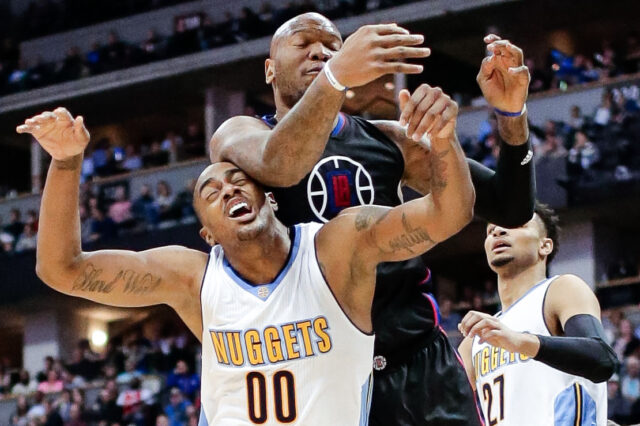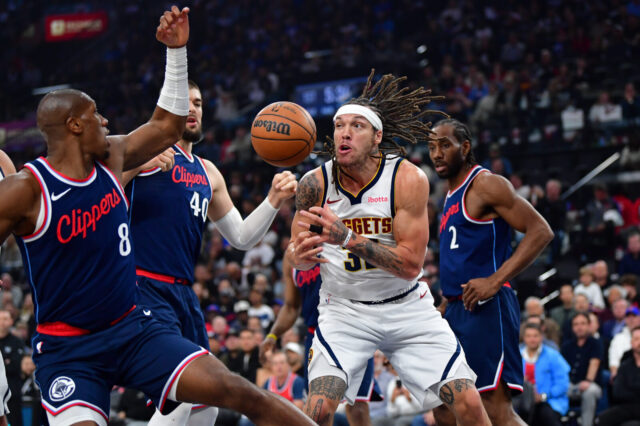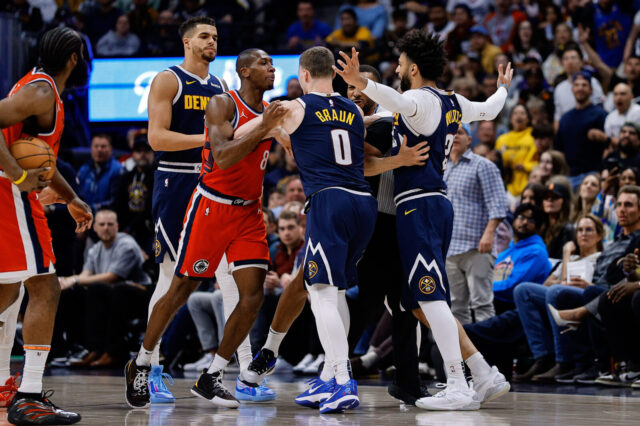 Denver Stiffs Power Rankings Series
Denver Stiffs Power Rankings Series 
| Top 50 Point Guards |
|---|
Player rankings are some of the most divisive conversations in the NBA. Every fan wants their player to rank highly, and every fan will question why their player isn’t ranked as highly as they want. Positional rankings are also difficult due to the blending of roles and position-less basketball.
But I’m going to do it anyway.
These rankings will consist of the top 50 players at each of the five widely accepted positions in the NBA: point guard, shooting guard, small forward, power forward, and center. There are different ways to classify it, but this is the best way to break down the talent into multiple categories.
Each list will be released on Wednesday of that week, starting with point guards and finishing with centers. A top 100 players in the NBA list could follow if the lists are well received.
Shooting Guard Criteria:
First, players that qualify for this list had to play predominantly shooting guard, based on their categorization on Basketball Reference. They will also play predominantly shooting guard next year.
Here are some primary players eliminated based on this criteria, as they play either point guard or small forward instead:
- Jimmy Butler
- Bojan Bogdanovic
- Kent Bazemore
- Thabo Sefolosha
- Malcolm Brogdon
- Devin Harris
- Jerian Grant
- Vince Carter
Second, only players that played 1,000 minutes in the NBA this past season were considered, which eliminates three parties: injured players, foreign players, and rookies.
Here are some noteworthy players eliminated based on this criteria:
- Khris Middleton
- Tomas Satoransky
- Denzel Valentine
- Ron Baker
- Bogdan Bogdanovic
- Malik Monk
- Luke Kennard
- Donovan Mitchell
Methodology:
Selecting criteria for wing players has been very difficult, much more so than criteria for point guards. With a point guard, the position has changed to fit more of a scoring and high usage role. You basically either have a guy like that, or you don’t. With a shooting guard, they are used as secondary ball handlers, primary ball handlers, spot-up shooters, post-up guys, and defensive stoppers. With so many different roles, it is hard to quantify impact when impact can be felt in so many different ways.
With that in mind, I focused again on weighting efficiency, usage, and defense the heaviest of all categories, taking the true shooting percentage, usage rate, and ESPN’s Defensive Real Plus-Minus as benchmarks for each category. Please understand that defense is incredibly hard to quantify, and that DRPM is an imperfect system, but it’s one of the most objective ways to quantify impact in a statistical ranking. Players like Gary Harris, Avery Bradley, and Kentavious Caldwell-Pope are unfairly penalized based off outside factors while using DRPM, and will thus be ranked lower than they should be.
I also took assists, rebounds, and minutes into account, both in total and in how many games played/started. This helps adjust for super subs on various teams. I have a single number generated for all shooting guards that will rank the 50 best players to play the shooting guard position this past season. Remember, this is statistically generated, and it’s not etched in stone that this is where these players should rank, nor how I would rank this list due to subjective biases.
Without further ado, let’s jump right into it:
Honorable Mentions (didn’t quite make the cut on the top 50):
- Iman Shumpert, Manu Ginobili, Nik Stauskas, Buddy Hield, Joe Harris, Josh Richardson, E’Twaun Moore, Ben McLemore, Jamal Murray, Monta Ellis, Alex Abrines, Rodney McGruder, Gerald Henderson, J.R. Smith, Jonathon Simmons, Troy Daniels, Patrick McCaw, Randy Foye, Brandon Rush
- Yes, that is Jamal Murray on the list. Buddy Hield is also there so fear not, Nuggets fans. Based on the criteria used for efficiency and size of role, Murray sunk to the bottom. If he had simply played more and started more games, his ranking on this list would have skyrocketed. I remain very high on Jamal Murray, folks.
- Other guys to show up are two Spurs in Ginobili and Simmons, who are better players than their ranking but suffered due to minimized roles. J.R. Smith was also secretly awful last season. Go figure.
Tier 1: Contextual Megastars
1. James Harden – Houston Rockets
Harden was pushed to the shooting guard position because of the presence of Chris Paul, but just a year ago, Harden was my top ranked shooting guard. Nothing has changed, except of course for the fact that he got better in every way and was runner-up for MVP.
Tier 2: The Rest of the Elite (volume scorers)
2. Bradley Beal – Washington Wizards
3. Klay Thompson – Golden State Warriors
4. C.J. McCollum – Portland Trail Blazers
5. DeMar DeRozan – Toronto Raptors
This tier of players could go in any order honestly, but it’s inarguable based on the utilized criteria that the four are next in line behind Harden. Beal, McCollum, and DeRozan are properly penalized for their defense, while Thompson is penalized for his ability to create for others. Still, the four rank 8th, 10th, 7th, and 1st overall in usage rate, as well as 4th, 11th, 14th, and 27th in true shooting percentage. DeRozan makes up for his drop off in efficiency by creating for others off the dribble. It’s not necessarily great creation, and he could be penalized for his lack of 3-point spacing, though I decided to forgo such an evaluation for every player.
Tier 3: Quality Starters (pick an order, any order you like)
6. Evan Fournier – Orlando Magic
7. Seth Curry – Dallas Mavericks
8. Tony Snell – Milwaukee Bucks
9. Eric Gordon – Houston Rockets
10. Zach LaVine – Chicago Bulls
11. J.J. Redick – Philadelphia 76ers
12. Victor Oladipo – Indiana Pacers
13. Gary Harris – Denver Nuggets
14. Tim Hardaway Jr. – New York Knicks
15. Wesley Matthews – Dallas Mavericks
First of all, this tier of players was so close together statistically, which is why of course I use tiers. These guys are very close based on the criteria utilized, from efficient players to highly skilled defenders to guys who rebound and assist well. Second, this part is also where I expect everyone to get mad. Seth Curry?! Tony Snell?! Surely these guys can’t be in the same tier as Gary Harris, right?
Well, from a subjective view, I agree. Harris does a lot of things for the Nuggets that cannot be explained using the statistical methods I used for this ranking. His usage rate is low, as are his assist and rebound rates. These are by design in the Nuggets offensive/defensive scheme, and they can’t be quantified for everyone, or else they become subjective. What ISN’T subjective though is his horrid defensive score. This doesn’t completely follow the eye test, but for the last three seasons, Denver has had a horrible defense with Harris on the floor. For some of these other players, that isn’t the case. I think there’s an argument to be made to move Harris toward the top of this tier of players, but I’m going to stick with the numbers.
So, to answer the question, why Seth Curry and Tony Snell? Because both were just as efficient with their true shooting percentage as a guy like Harris, and they each provided better defense as calculated by DRPM while adding on in other areas. LaVine shouldered a heavy burden in Minnesota, and he will fall down this list while in Chicago due to his ACL tear. Fournier’s impact was solid across the board except in rebounding. Gordon’s skills were maximized in a bench role, and he would have ranked 6th or so if not for minutes/role adjustments. Redick was an offensive stud who’s higher usage rate gave him the advantage over Harris. Hardaway Jr. was also average to above average as a sixth man in Atlanta, and the only spot Matthews struggled in was his shooting efficiency which might come back next season.
Tier 4: Average to below average starters
16. Lou Williams – Los Angeles Clippers
17. Nicolas Batum – Charlotte Hornets
18. Avery Bradley – Boston Celtics
19. Patrick Beverley – Los Angeles Clippers
20. Courtney Lee – New York Knicks
21. Andrew Wiggins – Minnesota Timberwolves
22. Nick Young – Golden State Warriors
23. Devin Booker – Phoenix Suns
24. C.J. Miles – Toronto Raptors
25. Dwyane Wade – Chicago Bulls
This category of players involves bench players who excelled in their role as well as starters who performed at mere average to below average levels in their role. Lou Williams was an amazing offensive player for the Lakers, but when he went to the Rockets, his field goal and 3-point percentages dropped massively. He could see a decline on this list if he can’t replicate that excellent first half. C.J. Miles is similar, in that his role will shift with a new team in Toronto. Will he be as efficient as he was in Indiana? Time will tell.
Nicolas Batum, Patrick Beverley, and Courtney Lee are standard vets that are average to above average in their roles. Batum has a large role in Charlotte, as evidenced by his combination of usage, assist, and rebound percentage, but he performed inefficiently. Beverley had a very small but defined role in Houston and performed very well. Courtney Lee had a reasonable role and performed…reasonably.
Nick Young was…good this season. The Warriors got better by adding him.
Dwyane Wade was…not good this season. The Bulls have to be excited to get LaVine back eventually.
Avery Bradley is a simple case of DRPM thinking that he’s a terrible defender when he’s actually elite. He belongs in the tier above.
People will want to talk about Booker and Wiggins, but they are in the same category as players like Kyrie Irving and Damian Lillard. Those guys fell in these rankings due to inability to do other things besides score, and Booker and Wiggins think they are Lillard/Irving types (Booker was actually a solid facilitator, but he was SO bad everywhere else that it knocked him down). Until those guys get more efficient, take more threes, rebound, and especially defend, they will have a hard time climbing these rankings.
Tier 5: Bad starters or quality bench guys
26. Tyler Johnson – Miami Heat
27. Allen Crabbe – Portland Trail Blazers
28. Dion Waiters – Miami Heat
29. Kentavious Caldwell-Pope – Los Angeles Lakers
30. Will Barton – Denver Nuggets
31. Jamal Crawford – Minnesota Timberwolves
32. Danny Green – San Antonio Spurs
33. Kyle Korver – Cleveland Cavaliers
34. Jason Terry – Milwaukee Bucks
35. Rodney Hood – Utah Jazz
36. Andre Roberson – Oklahoma City Thunder
Another confusing, versatile tier of players that are here for different reasons. Tyler Johnson and Dion Waiters will suit up for the Heat next season, and while Johnson will likely play more point guard behind Goran Dragic, I see him shooting up this list next year. Waiters on the other hand? He won’t. He’s too inefficient and is only this high because he holds the ball a lot. Most of the bench guys here (Allen Crabbe, Will Barton, Jamal Crawford, and Kyle Korver) seem to be properly rated. It’s good to see Will Barton this high, because he could move even higher after a year in the Nikola Jokic system (and also a contract year). Jason Terry seems a little high, but it helps to have the 8th best TS% and 9th best DRPM.
As we saw with Gary Harris and Avery Bradley, it’s hard to grade the 3-and-D guys accurately using DRPM. Danny Green and Kentavious Caldwell-Pope certainly apply here, though it’s understandable given their low usage rates and surprisingly low efficiency. Green only shot 37.9% from the 3-point line though on 4.6 attempts per game, and his gravity just isn’t what it was two years ago. Caldwell-Pope also has his issues, most notably that he’s actually a bad 3-point shooter for a 3-and-D guy.
Rodney Hood and Andre Roberson round out this section for various reasons. Hood had a down season efficiency wise and couldn’t create for others at all. Roberson is an All-Defensive talent, but it’s hard to be a total liability offensively. Most of this ranking is based on offensive measurements, so it’s understandable why he’s so low. I greatly value his defensive contributions, but this also puts in perspective just how bad he was on offense last year.
Tier 6: Average to below average bench players
37. Marcus Smart – Boston Celtics
38. Austin Rivers – Los Angeles Clippers
39. Justin Holiday – Chicago Bulls
40. Jeremy Lamb – Charlotte Hornets
41. Norman Powell – Toronto Raptors
42. Marco Belinelli – Atlanta Hawks
43. Wayne Ellington – Miami Heat
44. Arron Afflalo – Free agent
45. Tony Allen – Free agent
46. Sean Kilpatrick – Brooklyn Nets
47. Garrett Temple – Sacramento Kings
48. Glenn Robinson III – Indiana Pacers
49. Jordan Clarkson – Los Angeles Lakers
50. Ian Clark – Free agent
Here’s another mix of players that have risen or fallen for various reasons. Marcus Smart is on the verge of the next tier based on his playmaking and defense. His efficiency really hurts him though, which makes sense when you rank 68th out of 70 players in TS%. Austin Rivers is surprisingly good based on his reputation, but I’m mostly saying that because I want Doc Rivers to hire me. Justin Holiday may be the best healthy guard on the Bulls next year if Dwyane Wade comes to terms on a buyout.
Jeremy Lamb and Norman Powell are still relatively young guys who have struggled to find a role. This year, both should be asked to do a bit more, so it will be interesting to see how their numbers react. A trio of old guys in Belinelli, Afflalo, and Allen are all likely to be on the open market shortly (I expect Belinelli to find a buyout option with Atlanta), but the question is whether they can serve true rotation roles next year. Allen probably can, but it comes with the caveat that he can’t shoot at all.
Sean Kilpatrick is a name Nuggets fans are familiar with. He’s still establishing himself with the Brooklyn Nets, but he had a good year last year. Garrett Temple was a steady vet off the bench for the Kings last year, and he should serve a similar role this coming year. Glenn Robinson III should get more playing time with Paul George gone, which is good; he had a 56.4 TS% that went relatively unnoticed. Ian Clark and Jordan Clarkson are basically the same player, except one is getting to showcase himself on a bad team, and the other is playing limited and reasonably efficient minutes on a good team.
So, that wraps up this week’s power rankings list. Make sure to comment down below with thoughts about how the list came out, as well as any thoughts on lists going forward.
This content is no longer available.
This content is no longer available.


